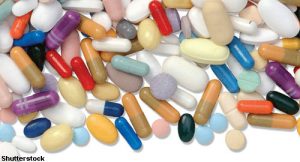 ACR CONVERGENCE 2020—The late-breaking abstract session at ACR Convergence covered a range of clinical trial results, from the use of tocilizumab for COVID-19 to mavrilimumab for remission of giant cell arteritis. Here’s a summary of various study findings shared during the session.
ACR CONVERGENCE 2020—The late-breaking abstract session at ACR Convergence covered a range of clinical trial results, from the use of tocilizumab for COVID-19 to mavrilimumab for remission of giant cell arteritis. Here’s a summary of various study findings shared during the session.
Tocilizumab for COVID-19
The use of tocilizumab, an interleukin-6 receptor blockade, did not prevent mechanical ventilation or death in patients who were moderately ill with COVID-19, reported John H. Stone, MD, MPH, professor of medicine, Harvard Medical School and the Edward A. Fox Chair in Medicine at Massachusetts General Hospital, Boston.
In a randomized, double-blind, placebo-controlled trial, 243 hospitalized patients with confirmed SARS-CoV2 infection were randomized 2:1 to standard care plus intravenous tocilizumab 8 mg/kg or placebo.1 The primary outcome was the time to mechanical ventilation or death within 28 days. The study took place from April to June 2020.
For progression to intubation or death, the hazard ratio was 0.83 in the treatment group; for disease worsening, the hazard ratio was 1.11. At 14 days, disease worsening had occurred in 18% of the tocilizumab patients vs. 14.9% of the placebo patients. Also at 14 days, 24.6% of tocilizumab patients still needed oxygen vs. 21.2% in the placebo group. Those treated with tocilizumab experienced fewer serious infections.
Twelve percent of patients in the study were intubated or died, Dr. Stone said.
One-third of patients in the trial had received remdesivir, and fewer than 10% received glucocorticoids.
Results from the trial were published in the Oct. 21 issue of the New England Journal of Medicine.2
Mavrilimumab Reduces Time to Flare
Mavrilimumab worked better than placebo for controlled time to flare and sustained remission at week 26 in a phase 2 trial with giant cell arteritis (GCA) patients, reported Maria C. Cid, MD, of the Department of Internal Medicine, Hospital Clinic, Barcelona.
The randomized, double-blind, placebo-controlled trial included 70 patients with active new onset or relapsing refractory GCA.3 Patients were randomized 3:2 to receive mavrilimumab 150 mg (n=42) or placebo (n=28) subcutaneously every two weeks, as well as a protocol-defined 26-week prednisone taper that started at 20 to 60 mg/day.
By week 26, disease flare occurred in 19% and 46.4% of patients receiving mavrilimumab and placebo, respectively. Researchers could not estimate the median time to flare by week 26 in the treatment group because too few events occurred. Sustained remission occurred in 83.2% of patients in the treatment group and 49.9% in the placebo group by week 26. The drug was well tolerated.
The results could help with the large unmet need for more GCA treatment options, Dr. Cid said.
Ziritaxestat
A phase 2a trial called NOVESA with 33 patients who have active diffuse cutaneous systemic sclerosis (dcSSc) found the autotaxin inhibitor ziritaxestat (GLPG1690) significantly improved their Rodnan skin score compared with placebo at week 24, said Dinesh Khanna, MD, director of the Scleroderma Program at the University of Michigan, Ann Arbor.
Per standard of care, 95.2% of ziritaxestat patients and 83.3% of placebo patients used background immunosuppressive therapy.4 Patients were randomized 2:1 for oral ziritaxestat 600 mg daily or matching placebo for 24 weeks. Patients were adults with a confirmed dcSSc diagnosis and a modified Rodnan skin score of more than 10 at screening. A statistically significant difference (least square mean difference, –2.8) in the mean Rodnan skin score was observed between the treatment versus placebo groups.
Two serious adverse events occurred in the ziritaxestat group and one in the placebo group, but they were likely not linked to the study drug.
Thirty-one of the 33 patients opted to continue in an open-label extension study to continue ziritaxestat for the next 48 months, Dr. Khanna said.
VIB7734, a Monoclonal Antibody
A phase 1 study with the monoclonal antibody VIG7734, which selectively targets plasmacytoid dendritic cells (pDCs), led to reduced blood and skin pDCs and a subsequent reduction in type 1 interferon levels in blood and inflamed skin among subjects with lupus, reported Victoria Werth, MD, professor of dermatology at the Hospital of the University of Pennsylvania, Philadelphia.
The randomized, double-blind, placebo-controlled, multiple ascending dose trial enrolled adult subjects in three sequential cohorts and a placebo group.5 Cohort 1 (n=6) included patients with systemic lupus erythematosus (SLE) or Sjögren’s syndrome; cohorts 2 and 3 (n=16 overall) included subjects with SLE or cutaneous lupus erythematosus with a CLE Disease Area and Severity Index Activity score of 8 or greater. The placebo group included nine subjects.
Subjects received treatment or placebo subcutaneously every four weeks, as well as three doses as an add-on. Levels of pDC were quantified in the blood and skin, and a type 1 interferon signature was measured.
At week 1, a decrease in circulating pDCs was seen, which continued through the three months of treatment. The median change in interferon 1 signature at three months was –54% in the VIB7734 50 mg group, –83% in the 150 mg group and +8% in the placebo group. Safety was similar among the treatment and placebo groups, Dr. Werth said.
Tofacitinib for Ankylosing Spondylitis
A phase 3, randomized, double-blind, placebo-controlled study with tofacitinib in patients with active ankylosing spondylitis (AS) indicated a rapid clinical response, said Atul Deodhar, MD, professor of medicine in the Division of Arthritis and Rheumatic Diseases, Oregon Health and Science University, Portland.
The 269 patients who were included were all adults who met modified New York Criteria and who had an inadequate response or intolerance of two or more non-steroidal anti-inflammatory drugs.6 During the 16-week double-blind phase, researchers randomized patients 1:1 to receive tofacitinib 5 mg twice daily or placebo. After week 16, all patients received open-label tofacitinib through week 48. By week 16, a significantly greater percentage of treatment patients (56.4% versus 29.4% for placebo) were ASA20 responders.
The safety profile with tofacitinib was consistent with that found in rheumatoid arthritis and psoriatic arthritis, Dr. Deodhar said. No new safety risks were identified.
Vanessa Caceres is a medical writer in Bradenton, Florida.
References
- Stone J. Tocilizumab for COVID-19 infection: A randomized, double-blind, placebo-controlled trial [abstract L07]. Arthritis Rheumatol. 2020 Oct;72(suppl 10).
- Stone JH, Frigault MJ, Serling-Boyd NJ, et al. Efficacy of tocilizumab in patients hospitalized with COVID-19. N Engl J Med. 2020 Dec 10;383(24):2333–2344. Epub 2020 Oct 21.
- Cid M, Unizony S, Pupim L, et al. Mavrilimumab (anti GM-CSF receptor α monoclonal antibody) reduces time to flare and increases sustained remission in a phase 2 trial of patients with giant cell arteritis [abstract L06]. Arthritis Rheumatol. 2020 Oct;72(suppl 10).
- Khanna D, Denton C, Furst D, et al. A phase 2a randomized, double-blind, placebo-controlled study of ziritaxestat in early diffuse cutaneous systemic sclerosis (NOVESA) [abstract L09]. Arthritis Rheumatol. 2020 Oct;72(suppl 10).
- Werth V, Karnell J, Rees W, et al. Targeting plasmacytoid dendritic cells improves cutaneous lupus erythematosus skin lesions and reduces type I interferon levels: Results of a phase 1 study of VIB7734 [abstract L10]. Arthritis Rheumatol. 2020 Oct;72(suppl 10).
- Deodhar A, Sliwinska-Stanczyk P, Xu H, et al. Tofacitinib for the treatment of adult patients with ankylosing spondylitis: Primary analysis of a phase 3, randomized, double-blind, placebo-controlled study [abstract L11]. Arthritis Rheumatol. 2020 Oct;72(suppl 10).



